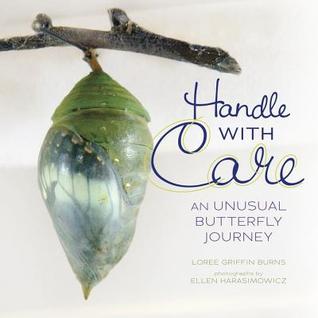NONFICTION MONDAY/PICTURE BOOK MONTH: Microbes, Butterflies, and Prairie
ABOUT THE BOOK
Some farms grow vegetables or grains, and some raise cows, sheep, chickens, or pigs. But have you ever heard of a butterfly farm? How do you raise a butterfly?
REVIEW
There are many different kinds of farms out there, but this is the first time I've heard of butterfly farms. It makes a great deal of sense that there would be such a thing, I've just never thought about it before now. This book beautifully describes what happens on a Costa Rican butterfly farm, how the butterflies are raised and transported to places around the world. The photographs do a wonderful job of illustrating what the author is describing. The extra information at the end is very useful, explaining the insect life cycle in terms of butterflies, beetles, and flies. The reference lists and glossary also make this a great resource as well as the link to further resources from the publisher. A wonderful book that would be very useful in teaching children about the life cycle of butterflies.
ABOUT THE BOOK
Find out how the smallest things on the planet do some of the biggest jobs in this intriguing introduction to the world of microbes.
All around the world -- in the sea, in the soil, in the air, and in your body -- there are living things so tiny that millions could fit on an ant's antenna. They're busy doing all sorts of things, from giving you a cold and making yogurt to eroding mountains and helping to make the air we breathe. If you could see them with your eye, you'd find that they all look different, and that they're really good at changing things into something else and at making many more microbes like themselves! From Nicola Davies comes a first exploration for young readers of the world's tiniest living organisms.
REVIEW
Microbes as organisms too small to be seen by the human eye are a topic that would be hard for children to understand since it's a rather abstract concept. Nicola Davies has done an excellent job in explaining the concept of these small creatures that out number people by many millions to one. The amazing world of microbes comes to life in Davies' words and Sutton's illustrations. There is just enough detail to be interesting without becoming overly complicated for the intended audience. The illustrations show the differences in sizes between different microbes and how different they look as well as how quickly they can multiply. It's a subject that can be rather overwhelming yet made palatable by the excellent work of Davies and Sutton.
ABOUT THE BOOK
Author Phyllis Root and illustrator Betsy Bowen last explored the vast, boggy peatlands of northern Minnesota in their book Big Belching Bog. Now, in Plant a Pocket of Prairie, Root and Bowen take young readers on a trip to another of Minnesota’s important ecosystems: the prairie.
Once covering almost 40 percent of the United States, native prairie is today one of the most endangered ecosystems in the world. Plant a Pocket of Prairie teaches children how changes in one part of the system affect every other part: when prairie plants are destroyed, the animals who eat those plants and live on or around them are harmed as well. Root shows what happens when we work to restore the prairies, encouraging readers to “plant a pocket of prairie” in their own backyards.
By growing native prairie plants, children can help re-create food and habitat for the many birds, butterflies, and other animals that depend on them. “Plant cup plants,” Root suggests. “A thirsty chickadee might come to drink from a tiny leaf pool. Plant goldenrod. A Great Plains toad might flick its tongue at goldenrod soldier beetles.” An easy explanation of the history of the prairie, its endangered status, and how to go about growing prairie plants follows, as well as brief descriptions of all the plants and animals mentioned in the story.
With Betsy Bowen’s beautiful, airy illustrations capturing the feel of an open prairie and all its inhabitants, readers of all ages will be inspired to start planting seeds and watching for the many fascinating animals their plants attract. What a marvelous transformation could take place if we all planted a pocket of prairie!
REVIEW
While the focus of this book is on Minnesota prairie and wildlife, the principles in regard to building a small prairie in your backyard certainly apply to a lot of other places. I loved how the author and illustrator go through the building of a prairie from one plant and animal to more and more until a full-blown prairie has taken root. I enjoyed hearing about the different animals and plants and how interconnected their lives were. It was sad though to think how little prairie is left in its natural state. This book would make a great teaching tool for teaching about the prairie habitat as well as teaching about environmental repair. A great resource and enjoyable look at the beauty of the natural world that we would do well to take care of before it's gone altogether.








Thanks for the review of Plant a Pocket of Prairie. This sounds like a great tie-in with the elementary science curriculum in Alberta. I'll look for it.
ReplyDeleteTammy
Apples with Many Seeds